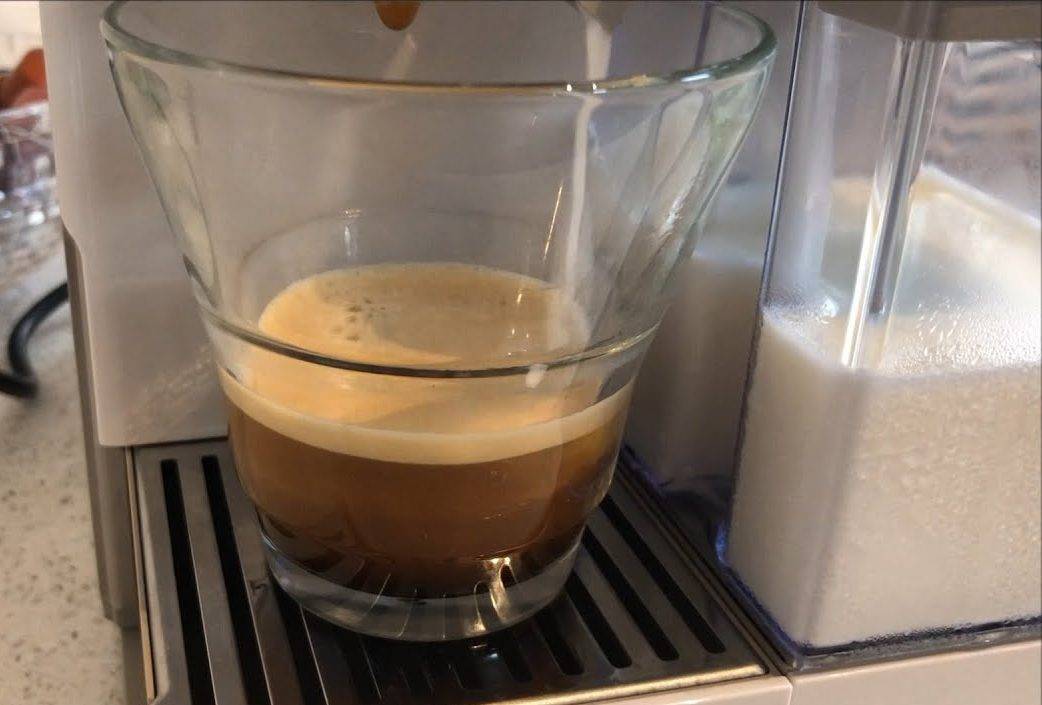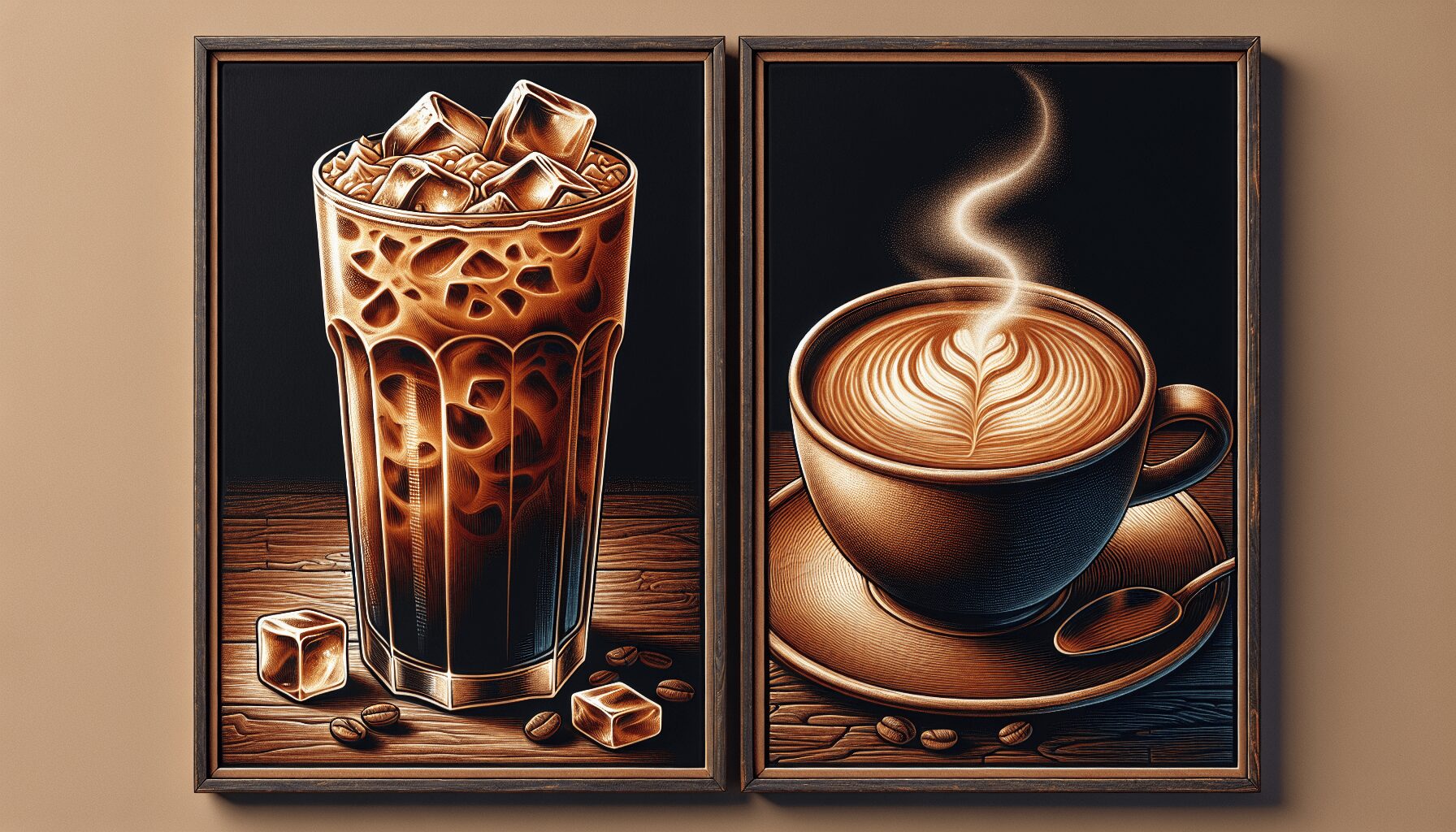In the wonderful world of caffeinated beverages, confusion often arises when trying to distinguish between iced coffee and latte. While both are equally delicious and refreshing, it’s important to understand the subtle nuances that set them apart. From the brewing methods to the addition of creamy milk, this article will unravel the mysteries behind these two popular choices, so you can confidently order your favorite at your local coffee shop.
Definition
What is Iced Coffee?
Iced coffee is a refreshing and chilled beverage made by brewing coffee and then chilling it. It can be enjoyed on its own or with added milk, sweeteners, or flavorings. The coffee is typically brewed using any traditional method, such as drip brewing or cold brewing, before being poured over ice. Iced coffee is known for its cool, bold flavor and is a popular choice among coffee lovers, especially during warmer seasons.
What is a Latte?
A latte, also known as a caffe latte, is a popular espresso-based beverage that originated in Italy. It consists of a shot or two of espresso combined with steamed milk, creating a creamy and velvety texture. A latte is typically served in a large cup and can be enjoyed as is or with added flavorings like vanilla or caramel syrup. It is often topped with a layer of frothed milk to enhance its presentation. Lattes offer a balanced taste of espresso and milk, making them a go-to choice for those who enjoy a smooth and mellow coffee experience.
Ingredients
Iced Coffee Ingredients
To make a delicious iced coffee, you will need the following ingredients:
- Coffee beans or ground coffee
- Cold water
- Ice cubes
- Optional: milk or cream, sweeteners (sugar, honey, etc.), flavorings (vanilla extract, chocolate syrup, etc.)
Latte Ingredients
To prepare a delightful latte, gather the following ingredients:
- Espresso shots
- Milk (any variety, such as whole, skim, almond, or soy)
- Optional: flavorings (vanilla, caramel, hazelnut, etc.), sweeteners
Preparation Method
Iced Coffee Preparation
To make iced coffee, follow these simple steps:
- Brew a pot of coffee using your preferred method, ensuring a stronger brew than usual.
- Allow the coffee to cool to room temperature.
- Fill a glass with ice cubes.
- Pour the cooled coffee over the ice cubes, leaving some room for additional ingredients like milk or sweeteners.
- Stir well and adjust the taste by adding milk, cream, sweeteners, or flavorings according to your preference.
- Serve and enjoy your refreshing iced coffee!
Latte Preparation
To prepare a perfect latte, follow these steps:
- Brew one or two shots of espresso using an espresso machine or a stovetop espresso maker.
- In a separate pitcher, steam the milk to achieve a creamy and velvety texture. Take care not to overheat it.
- Pour the espresso shots into a large cup.
- Slowly pour the steamed milk over the espresso, holding back frothed milk with a spoon.
- Add the frothed milk to the top of the latte, creating a layer of creamy foam.
- Customize your latte by adding flavorings or sweeteners of your choice.
- Serve your delicious latte while it’s hot and savor the rich flavors!
Coffee-to-Milk Ratio
Iced Coffee Ratio
The coffee-to-milk ratio for iced coffee can vary depending on personal preferences. Some prefer a stronger coffee flavor and prefer a higher amount of coffee to milk ratio, while others enjoy a smoother and milder taste with more milk. As a general guideline, a common ratio is around 1 part coffee to 2 parts milk for an enjoyable balance of flavors. Feel free to adjust the ratio according to your taste preferences.
Latte Ratio
In a classic latte, the coffee-to-milk ratio is typically 1:3 or 1:4. This means that for every shot of espresso, you use three to four times the amount of steamed milk. This ratio allows the espresso’s boldness to shine through while providing a creamy and smooth texture. However, the ratio can be adjusted based on personal preference, allowing for a stronger or milder coffee taste.
Temperature
Iced Coffee Temperature
Iced coffee is typically served chilled, which means it should be cold enough to provide a refreshing experience. The ideal temperature range for iced coffee typically falls between 32°F (0°C) and 40°F (4°C). This temperature range ensures that the coffee remains cool and crisp without any dilution or significant melting of the ice cubes.
Latte Temperature
A latte is best enjoyed when served hot, showcasing the harmonious combination of espresso and steamed milk. The ideal temperature for a latte ranges from 150°F (65°C) to 160°F (71°C). This temperature allows the flavors to meld together while retaining the desired warmth for a comforting and enjoyable coffee experience.
Serving Style
Iced Coffee Serving Style
Iced coffee is commonly served in a tall glass or plastic cup filled with ice cubes. The coffee is poured over the ice, and additional ingredients like milk or sweeteners can be added before stirring well. Some people prefer to garnish their iced coffee with whipped cream, chocolate shavings, or a sprinkle of cocoa powder for added visual appeal. A straw is often provided for convenient sipping.
Latte Serving Style
A latte is traditionally served in a large, rounded cup or mug to accommodate the generous amount of steamed milk. The espresso and steamed milk are combined to create a layered look, with the frothed milk forming a delicate layer on top. Latte art, created by skillfully pouring the milk, may be seen on the surface, adding an artistic touch. The latte is generally enjoyed without a straw, allowing the flavors and textures to be experienced directly.
Flavor Profiles
Iced Coffee Flavor
Iced coffee offers a diverse range of flavor profiles based on various factors such as the type of coffee beans, brewing method, and any added ingredients. It typically boasts a bold and robust flavor, with subtle hints of bitterness and acidity. The chillness of the beverage can mellow down the coffee’s intensity and bring out its refreshing qualities. As iced coffee can be customized with milk, cream, or flavorings, it allows for a wide spectrum of taste variations to suit individual preferences.
Latte Flavor
The flavor of a latte is characterized by its delicate balance between espresso and steamed milk. The espresso contributes a strong and complex flavor profile, usually featuring notes of bitterness and rich earthiness. The steamed milk brings a creamy and slightly sweet taste, rounding off the espresso’s intensity. The combination creates a smooth, velvety, and well-rounded flavor that is often enjoyed for its milder and comforting qualities.
Caffeine Content
Iced Coffee Caffeine
The caffeine content in iced coffee can vary depending on various factors, including the type of coffee beans used and the brewing method. On average, an 8-ounce (240 ml) serving of iced coffee contains approximately 80-120 milligrams of caffeine. However, it’s essential to note that the caffeine levels can differ significantly based on variables such as the coffee-to-water ratio during brewing and the specific coffee beans’ caffeine content.
Latte Caffeine
The caffeine content in a latte primarily depends on the number of espresso shots used. A single shot of espresso typically contains around 63 milligrams of caffeine. Therefore, a typical 12-ounce (355 ml) latte made with two shots of espresso will provide approximately 126 milligrams of caffeine. However, it’s worth mentioning that different coffee shops may use different espresso shot sizes or brew methods, which can affect the final caffeine content.
Popular Variations
Popular Iced Coffee Variations
Iced coffee is a versatile beverage that allows for numerous delicious variations. Here are some popular options you might encounter:
- Iced Vanilla Latte: Add a splash of vanilla syrup to your iced coffee for a delightful hint of sweetness and aromatic flavor.
- Mocha Iced Coffee: Enhance your iced coffee by stirring in some chocolate syrup or cocoa powder, transforming it into a rich and indulgent mocha treat.
- Vietnamese Iced Coffee: Incorporate condensed milk into your iced coffee, following the traditional Vietnamese recipe, for a unique combination of sweetness and robust coffee flavor.
- Coconut Iced Coffee: Add a tropical twist to your iced coffee by using coconut milk instead of regular milk, creating a creamy and exotic refreshment.
Popular Latte Variations
The classic latte can be customized with various flavorings and toppings to suit individual taste preferences. Some popular latte variations include:
- Caramel Latte: Sweeten up your latte with a drizzle of caramel sauce for a delightful combination of creamy coffee and rich caramel flavors.
- Hazelnut Latte: Add a touch of nuttiness to your latte by incorporating hazelnut syrup, infusing the drink with a warm and comforting essence.
- Matcha Latte: Swap out espresso for matcha green tea powder, creating a vibrant and slightly earthy latte bursting with antioxidants.
- Iced Pumpkin Spice Latte: Perfect for fall, this latte variation blends pumpkin spice syrup with a chilled latte, providing a cozy and seasonal flavor experience.
Occasions and Preferences
Iced Coffee Usage
Iced coffee is beloved by many for its invigorating nature and ability to provide a rejuvenating boost, especially during warmer months. It is often enjoyed as a refreshing drink on a hot summer day or as a pick-me-up throughout the day. Iced coffee can be customized to match personal taste preferences, allowing individuals to choose their preferred strength, sweetness, or additional ingredients. Whether you’re relaxing by the pool or in need of a little energy, iced coffee is a versatile choice for various occasions.
Latte Usage
Lattes are favored for their smooth and creamy texture, providing a comforting and soothing experience. They are commonly enjoyed as a morning beverage to start the day on a positive note or as an afternoon treat to unwind. Latte’s versatility makes it suitable for various occasions, including social gatherings, cozy moments at home, or as a companion during focused work or study sessions. The ability to customize the flavorings and sweetness level allows individuals to tailor their lattes to their specific preferences.



